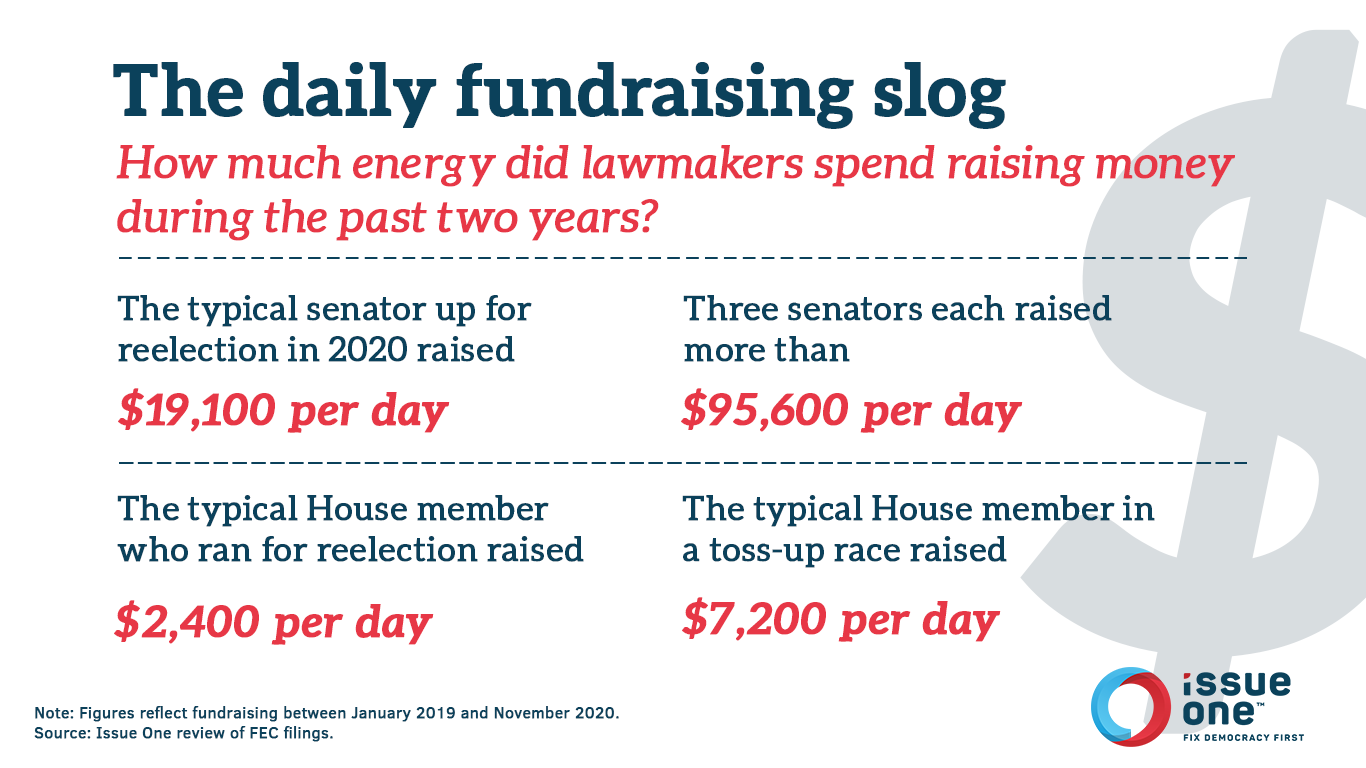Recently filed campaign finance reports help paint a full picture of exactly how much money House and Senate candidates raised and spent during the 2020 election cycle.
The bottom line: Lawmakers — especially those in the most competitive races — are under intense pressure to raise money, each and every day.
Here are some key numbers to know, based on an Issue One review of these new filings.
$13.2 million
The median amount of money raised between January 2019 and November 2020 by a sitting senator running for reelection in 2020 was $13.2 million — the equivalent of about $19,100 per day. That was far more than senators who were not up for reelection this year.
$674 million
Senators running for reelection raised about $674 million between January 2019 and November 2020. More than a third of that money came from just three senators, who each raised more than $60 million — Sens. Mitch McConnell (R-KY), Martha McSally (R-AZ), and Lindsey Graham (R-SC), who alone raised $105 million, nearly eight times as much money as the typical senator up for reelection.
$1.7 million
The median amount of money raised during the entire 2020 election cycle by a member of the House of Representatives who stood for reelection in November was approximately $1.7 million — meaning they raised, on average, about $2,400 per day. Meanwhile, the median amount raised by House freshman was about $3.4 million — or about $4,900 per day. And the typical House incumbent running for reelection in a race rated as a toss-up by the Cook Political Report raised roughly $5 million during the entire 2020 election cycle — about $7,200 per day, or nearly three times as much money as the typical House member.
$1.1 billion
Combined, all House members running for reelection in 2020 raised about $1.1 billion from individuals, political action committees, and other sources during the entire 2020 election cycle.
95%
Portion of members of Congress who were reelected in November 2020, including at least 95% of House members who ran for reelection in 2020 and at least 90% of senators. Two additional senators — Sens. Kelly Loeffler (R-GA) and David Perdue (R-GA) — are vying to be reelected in runoff elections that will occur on Jan. 5, 2021, and two House races remain unresolved amid legal challenges. Three senators and 19 House members running for reelection were defeated by challengers in November. Another eight House members lost primaries earlier this year — a record number for recent decades.
89%
As of Election Day, 89% of incumbent members of Congress had leadership PACs, political action committees that operate in addition to lawmakers’ official campaign committees — and which are often criticized by liberals and conservatives alike as slush funds. Just two senators did not have a leadership PAC, and just 13% of House members did not have leadership PACs. Created in the late 1970s as a way for members of Congress to raise extra money to give away to fellow politicians, leadership PACs open the door to corruption in two ways: Their funding often comes from special interest groups with business before Congress, and some politicians use them to fund lavish lifestyles, often under the guise of fundraising.
46%
Of the at least 60 new House members* that will be sworn in next month as part of the 117th Congress, 29 — 48% — have already formed leadership PACs, including 20 who formed leadership PACs prior to Election Day. And four of the six incoming freshman senators have already formed leadership PACs. As of Nov. 3, 73% of all freshman House members in the current 116th Congress had formed leadership PACs.
*Note: Two House races — Iowa’s 2nd Congressional District and New York’s 22nd Congressional District — remain uncalled by the Associated Press, and litigation pertaining to them is still ongoing.






